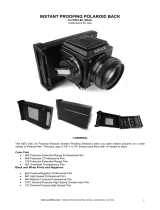
2 ProPack Camera
TABLE OF CONTENTS
PAGE
DATE CODE ............................................................................................................. 3
LIST OF ILLUSTRATIONS .....................................................................................
4
1. DESCRIPTION ............................................................................................... 5
General ................................................................................................ 5
Similarities to Reporter/EE100 ........................................................... 6
Film ......................................................................................... 6
Erecting System ...................................................................... 7
Focusing .................................................................................. 7
Framing ................................................................................... 7
Taking the Picture ................................................................... 8
Electronic Shutter.................................................................... 8
Other Similar Features ............................................................ 8
New Features....................................................................................... 8
Electronic Flash Capability..................................................... 8
CB103 Camera Back............................................................. 10
Electronic Timer.................................................................... 10
Film Selector......................................................................... 12
Hot Shoe Pin Functions..................................................................... 13
Film/Camera Exposure Characteristics ............................................. 14
2. TESTING & ADJUSTMENTS .................................................................... 15
Preliminary Checkout........................................................................ 15
Lens Collimation ............................................................................... 15
Shutter Exposure Tests .......................................................... 17
Setup...................................................................................... 17
Testing ................................................................................... 18
80/50 Flash............................................................................ 19
80/800.................................................................................... 19
3000ER/50 ............................................................................ 19
Camera/Electronic Flash Graywall Test ............................................ 19
Setup...................................................................................... 20
Partial Strobe Output............................................................. 21
Full Strobe Output ................................................................ 21
Flash Socket Check and Adjustment................................................. 22
Shutter Visual Inspection................................................................... 22
Timing Switch (S2) Adjustment........................................................ 24
Bellows Light Leak Check................................................................ 24
3. TROUBLESHOOTING................................................................................ 25
Flashcube Problems........................................................................... 25
Electronic Flash Problems (Camera Related) ................................... 27
Camera/Shutter Problems.................................................................. 29
4. DISASSEMBLY............................................................................................. 30





















